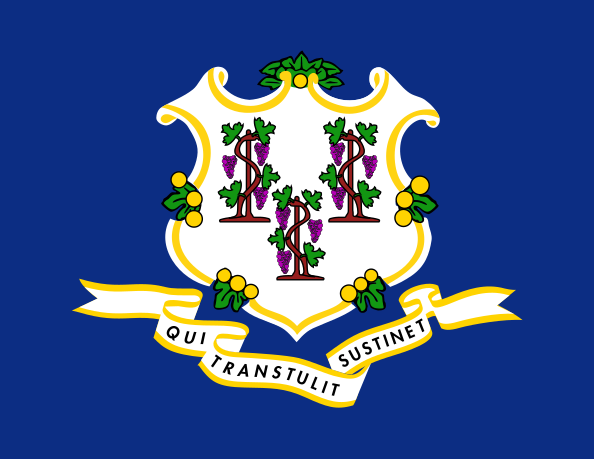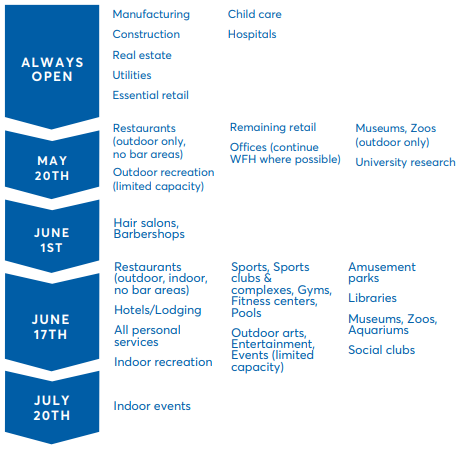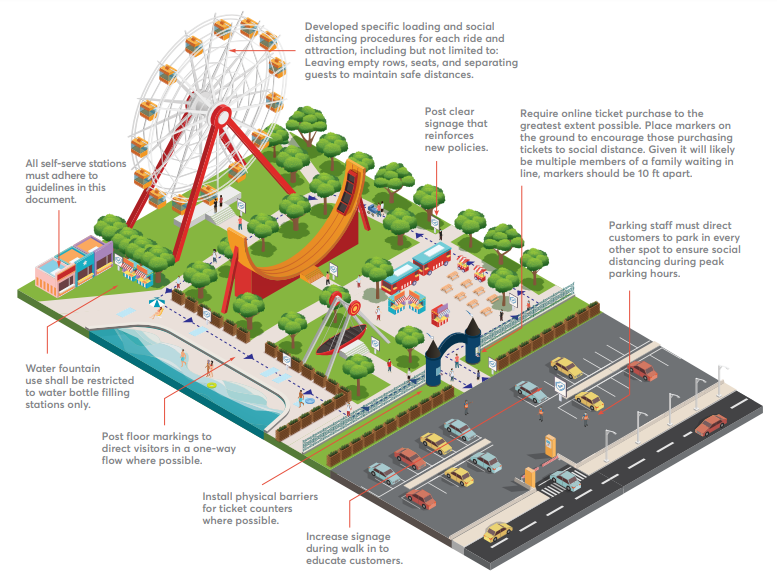Title Page
-
Site
-
Conducted on
-
Prepared by
-
Location
SECTOR RULES FOR JUNE 17TH REOPEN
-
GOAL
Proactively protect public health and speed up the pace of economic, educational, and community recovery while restoring Connecticut’s quality of life. -
1 - SAFETY FIRST<br>We will reopen society safely and securely with a proactive program that safeguards the health of our vulnerable residents, continues physical distancing, and provides clear safeguard rules for businesses and 1 institutions deemed safe to reopen.
-
2 - SCIENCE-DRIVEN<br>Our strategy will rely on a scientifically validated set of public health interventions. Patient assessment, testing, proactive tracing, field studies, and public health guidance will be deployed simultaneously to contain infection.
-
3 - PREPARED<br>We will work closely with hospitals and health systems to procure and distribute critical personal protective equipment, and assess capacity of beds and ventilators to ensure optimal standard of care
-
4 - CHOICE<br>Individual businesses within sectors allowed to open are empowered to make their own choice on when they reopen. When they open, they must comply with rules we lay out to safeguard their employees and customers
-
5 - DYNAMIC<br>We include a suite of tools to inform an adaptive plan that can be nimbly scaled or rolled back rapidly based on real-time critical health metrics.
HOW WE WILL OPEN OUR ECONOMY SAFELY
-
Our plan to open the economy will address two factors:
WHAT businesses can open and when.
HOW businesses must operate if they choose to open.
WHAT
-
• We know that some businesses put employees and customers at greater risk of transmission.
-
• We will prioritize opening businesses that pose a lower transmission risk and drive outsized impact on the economy.
-
• Transmission risk is defined as contact intensity and modification potential of businesses.
-
- Contact intensity considers contact proximity, contact length, and number of contacts.
-
- Modification potential considers the businesses’ ability to socially distance and sanitize in accordance with regulations.
-
• We will assess the impact on state economic health with a focus on number of employed individuals, total GDP impacted, and impact on small businesses that<br> make up the backbone of our economy.
HOW
-
• We will provide clear operational guidance to businesses on how to reopen while ensuring the safety of both employees and customers.
-
• Guidance will include social distancing and hygiene, as well as the use of personal protection – for business operators, workers, and customers.
-
• The goal is to not only open safely, but create confidence in our society across employers, employees, and customers.
-
• The level of guidance will gradually become less restrictive over time, as our confidence in the ability to monitor and contain the disease increases.
WHAT: SECTOR REOPENING OVER TIME
-
-
The state will open its economy with a gradual approach.<br>The first set of businesses started reopening when we saw a sustained 14-day decline in hospitalizations, had adequate testing capacity, had a contact tracing system in place, and had procured sufficient PPE. The timing for that reopen was May 20th.
HOW: SAFEGUARDS
-
As we continue to reopen select businesses on June 17th, we will open at our strictest controls onbusiness operations and societal interaction. This will include, among other measures:
-
• Capacity limit of 50% for most businesses that reopen.
-
• Strict cleaning and disinfection protocols in all settings.
-
• Those who can work from home should continue to do so.
-
• Those in high-risk groups (comorbidities) and over the age of 65 should continue to stay safe and stay home.
-
• Facemasks should continue to be worn in public at all times.
-
• Social gatherings will be restricted in accordance to the Governor's executive order.
-
As we see progress on a defined set of public health metrics (detail to follow), we will gradually
loosen safeguards. This will allow for the next set of businesses to open and potentially for
businesses already open to operate with additional leeway. We expect this will occur over the coming months.
As always, we will make decisions based on data and science. Our plan intentionally allows for
sufficient time for learning, adoption of behaviors, and ultimately the achievement of improved
health metrics that create the necessary environment for new business operations. If public health metrics deteriorate, the State may choose to revert back to stricter safeguards.
AMUSEMENT PARKS OUTDOOR ONLY
-
OVERVIEW
As Connecticut reopens its outdoor amusement parks, the State wants to enable its citizens to continue to enjoy rides and activities, as well as some quality time outdoors. Such activities must be undertaken only after prioritizing the health and safety of employees and consumers. This set of rules developed by the State of Connecticut aims to minimize the risks presented by these establishments while allowing its citizens to enjoy the state's cultural treasures.
Amusement parks must exercise caution throughout the reopening, ensuring strict adherence to the protocols listed here. Those businesses that are not able to meet the rules listed here by June 17, shall delay opening until they are able.
While these rules provide a way for amusement parks to reopen as safely as possible, risks to visitors and employees cannot be fully mitigated. Visitors who choose to come to amusement parks during this time should be aware of potential risks. Individuals over the age of 65 or with other health conditions should not visit amusement parks, but instead continue to stay home and stay safe.
Amusement parks should take these rules as the minimum baseline of precautions needed to protect public health in Connecticut. Individual establishments should take additional measures as recommended by industry guidelines or by common sense applied to their particular situation. We also urge visitors to stay vigilant and pay attention as to whether the amusement parks they visit are faithfully implementing these rules. -
STATE GUIDANCE FOR AMUSEMENT PARKS
Amusement parks shall calculate maximum safe occupancy for each ride area/room to allow for social
distancing between groups and to comply with state social gathering size guidance. Establishments shall leverage signage, floor markings, and enhanced presence of attendants and other personnel to enforce such occupancy rate.
These rules are intended to help amusement parks safely get back to work. The information here can be supplemented with guidance from professional organizations and by other industry groups, some of
which are listed below. These rules may be updated.
FURTHER RESOURCES IAAPA
https://www.iaapa.org/reopening-guidance-considerations-attractions-industry
NEAAPA
https://growthzonesitesprod.azureedge.net/wp-content/uploads/sites/1403/2020/05/NEAAPA-COVID-19-Reopening-Guidance.pdf
OSHA
https://www.osha.gov/Publications/OSHA3990.pdf -
PLAN FOR REOPENING<br>Share these rules with your employees and inform them of any additional specific measures being taken in response to COVID-19.
-
PROGRAM ADMINISTRATOR<br>Appoint a program administrator who is accountable for implementing these rules.
-
CLEANING PLAN<br>Develop cleaning checklists that incorporate these rules. Ensure it is clear which employees are responsible for implementing the plans.
-
TRAINING<br>The employer shall institute a training program and ensure employee participation in the program. Training shall be provided at no cost to the employee and during working hours. The training materials shall be presented in the language and at the literacy level of the employees. Employers shall continuously update staff on changes to these Sector Rules. The training shall include:<br><br>• Guidelines outlined in this document<br> • Protocols on how to clean and use cleaning products (including disinfectants) safely<br> • Additional guidance can be found here:<br>https://osha.washington.edu/sites/default/files/documents/FactSheet_Cleaning_Final_UWDEOHS_0.pdf
-
NOTE: If any on-site duties are subcontracted, it is the employer’s responsibility to ensure subcontractors are also appropriately trained.
-
PERSONAL PROTECTION<br>Estimate required personal protection for employees and begin procuring.
-
LOG EMPLOYEES<br>Maintain a log of employees on-premise over time, to support contact tracing.
-
THOROUGH CLEANING<br>Complete a thorough cleaning of facility prior to reopening, including but not limited to:<br> • Rides<br> • High traffic areas such as ticket counters<br> • Restrooms
-
SHIFTS<br>Stagger shift start/stop times, break times, and lunchtimes to minimize contact across employees
-
CERTIFICATION<br>Complete the self-certification on the DECD website to receive a Reopen CT badge. Once complete, businesses can choose to post the badge on-site and on social media to advertise adherence to CT rules and build customer confidence.
-
-
Developed specific loading and social distancing procedures for each ride and attraction, including but not limited to: Leaving empty rows, seats, and separating<br>guests to maintain safe distances.
-
Post clear signage that reinforces new policies.
-
Require online ticket purchase to the greatest extent possible. Place markers on the ground to encourage those purchasing tickets to social distance. Given it will likely<br>be multiple members of a family waiting in line, markers should be 10 ft apart.
-
Parking staff must direct customers to park in every<br>other spot to ensure social distancing during peak<br>parking hours.
-
All self-serve stations must adhere to guidelines in this<br>document.
-
Water fountain use shall be restricted to water bottle filling<br>stations only.
-
Post floor markings to direct visitors in a one-way<br>flow where possible.
-
Install physical barriers for ticket counters where possible.
-
Increase signage during walk in to educate customers.
-
PARKING<br>Parking staff must direct customers to park in every other spot to ensure social distancing during peak parking hours. <br>
-
WALKWAYS INTO PARK<br>Increase signage during walk in to educate customers.
-
SOCIAL DISTANCING<br>Calculate maximum number of people allowed under the rules for each exhibition room/ride.<br> • Attendants to remain at same workstation through day to minimize movement.<br> • Attendants to enforce maximum occupancy per exhibition room/area where possible.
-
TICKET AREAS & FRONT GATE<br>Require online ticket purchase to the greatest extent possible. Place markers on the ground to encourage those<br>purchasing tickets to social distance.<br>Given it will likely be multiple members of a family waiting in line, markers should be 10 ft apart.<br> • Install physical barriers for ticket counters.
-
RIDES & ATTRACTIONS<br>Develop specific loading and social distancing procedures for each ride and attraction, including but not limited to:<br> • Leaving empty rows<br> • Seats<br> • Separating guests to maintain safe distances
-
RIDE LINES<br>Rearrange ride queues (such as “maze-style” queues typical at amusement parks) to prevent patrons waiting in line from having to pass others face-to-face within 6 ft where possible.
-
SIGNAGE<br>Post clear signage that reinforces new<br>policies, e.g.:<br> • Maximum occupancy of each exhibit<br> area/room<br> • Social distancing protocols (including<br> walkways into park)<br> • Cleaning and disinfection protocols<br> • Personal protection protocols (face masks, gloves) for customers and employees<br> • Employees shall stay home if sick/experiencing symptoms<br> • Customers shall not enter if they are experiencing symptoms<br> • Additional signage can be found here:<br>https://portal.ct.gov/DECD/Content/Coronavirus-Business-Recovery/COVID-19-Signage-for-Download
-
LOCKER ROOMS<br>Disable or mark every other or every third locker for non-use to enforce 6 ft social distancing requirement.<br>• Remove any casual seating other than benches by lockers as necessary.<br>•If independent showers are available and used, they must be attended and sanitized between each use.<br>• Disable or close-off communal style showers except for rinsing before and after any pool activity.
-
SELF-SERVICE STATIONS<br>Self-serve beverage stations are allowed but must adhere to the guidelines below. All other self-serve items must remain closed.<br>• Hand sanitizer must be made available next to beverage stations and operators must require customers to use before pouring beverages. Only cello or paper wrapped straws and stirrers are allowed. Cups and lids must be from single pull dispenser or other method to minimize contact. Sweeteners, sugars and creamers must be individual packets. Floor markers must be installed to achieve social distancing. Samplings and refills of personal<br>mugs and cups are not allowed. Frequent disinfecting of the beverage station must take place, even during busy times.
-
WATER FOUNTAINS<br>Water fountain use shall be restricted to water bottle filling stations only. Congregating at water bottle filling stations<br>shall be limited and signage reinforcing the use of water bottle filling stations only must be displayed.
-
SHARED EQUIPMENT<br>Ensure employees do not share equipment to the extent possible; if shared, clean after each use
-
RESTAURANTS & FOOD<br>Follow Sector Rules for Restaurants.
-
TOUCHLESS APPLIANCES<br>Install touchless appliances wherever possible,<br>including:<br>• Paper towel dispensers<br>• Soap dispensers<br>• Trash cans
-
GIFT SHOPS<br>Follow Sector Rules for Retail & Malls.
-
ONE-WAY FLOW<br>Post floor markings to direct visitors in a one-way flow where possible.
-
HOTLINE FOR VIOLATIONS<br>Post clear signage that includes the state hotline (211) for employees and customers to report potential violations of these rules.
-
PERSONAL PROTECTION FOR EMPLOYEES<br>• All employees are required to wear a facemask or other cloth face covering that completely covers the nose and mouth. Employees that cannot wear a mask due to a<br>medical condition must provide documentation to their employer.<br>• Employees may utilize their own cloth face covering over that provided by their employer if they choose.<br>• Gloves and eye protection are required when using cleaning chemicals
-
EMPLOYERS ARE RESPONSIBLE FOR PROVIDING PERSONAL PROTECTION TO THEIR EMPLOYEES<br>• If businesses do not have adequate personal protection, they cannot open
-
PERSONAL PROTECTION FOR CUSTOMERS<br>Customers are required to bring and wear facemasks or cloth face coverings that completely cover the nose and mouth.<br>• For water parks, pools, and water rides, the CDC recommends encouraging the use of cloth face coverings as feasible. Face coverings are most essential in times when physical distancing is difficult.<br>• Advise those wearing face coverings to not wear them in the water. Cloth face coverings can be difficult to breathe through when they’re wet.<br>• Businesses have the right to refuse service to an individual who is not wearing a facemask.
-
HAND SANITIZER<br>Hand sanitizer shall be made available at entrance points and common areas, where possible.
-
HANDWASHING<br>Ensure employees wash their hands routinely using soap and water for at least 20 seconds.
-
CLEANING, DISINFECTANT PRODUCTS, &/OR DISPOSABLE<br>DISINFECTANT WIPES<br>Make available near commonly used surfaces, where possible (e.g., ticket counters).
-
BATHROOMS<br>Clean and disinfect frequently, and implement use of cleaning log for tracking.<br>Clean multiple times a day and hourly during busy times.<br> • Recommend posting signage encouraging reduced capacity in bathrooms, and reminding individuals to wash their hands and wear a mask<br> • Consider placing a wastebasket outside of the bathroom
-
RIDES<br>Ride attendants will frequently clean and disinfect seats and restraints.
-
ATTRACTIONS<br>Attractions shall be cleaned and disinfected frequently.
-
CLEANING & DISINFECTING<br>Businesses shall follow federal guidelines (CDC, EPA) on what specific products shall be used and how:<br> • Disinfectants are irritants and sensitizers and should be used cautiously. Clean and disinfect frequently touched surfaces (e.g., door handles, cash registers) at least daily and shared objects (e.g., payment terminals) after each use.<br> • Use products that meet EPA’s criteria for use against SARS-CoV-2 and that are appropriate for the surface. Prior to wiping the surface, allow the disinfectant to sit for the<br> necessary contact time recommended by the manufacturer. Train staff on proper cleaning procedures to ensure safe and correct application of disinfectants.
-
DAILY HEALTH CHECK<br>Ask employees resuming on-premise work to confirm they have not experienced COVID-19 <br>CDC-defined symptoms and to monitor their own symptoms, including cough, shortness of breath, or any two of the following symptoms:<br><br> • Fever<br> • Chills<br> • Repeated shaking with chills<br> • Muscle pain<br> • Headache<br> • Sore throat<br> • New loss of taste or smell<br><br>Employees should stay home if sick.
-
IN THE EVENT OF A POSITIVE COVID-19 CASE<br>Employees should inform their employers, and follow state testing and contact tracing protocols. In addition:<br> • Employee should contact local public health to initiate contact tracing.<br> • Recommend 24-hour passive decontamination in the event of a positive case, and follow CDC guidelines<br> for cleaning and disinfecting.<br> • Additional information can be accessed at:<br> https://www.cdc.gov/coronavirus/2019-ncov/<br> community/general-business-faq.html
-
LEAVE<br>Employers shall adhere to federal guidance pertaining to paid leave for employees and provide this guidance to employees.<br>Employers shall post the Families First Coronavirus Response Act (FFCRA) Department of Labor poster. The poster can be accessed at:<br>https://www.dol.gov/agencies/whd/posters<br>• Additional guidance can be accessed at:<br> https://www.dol.gov/agencies/whd/<br> pandemic/ffcra-employee-paid-leave
-
WHISTLEBLOWER PROTECTION<br>Employers may not retaliate against workers for raising concerns about COVID-19 related safety and health conditions.<br> • Additional information can be accessed at www.whistleblowers.gov<br> • Additional information for the public sector can be accessed at www.connosha.com
Audit Completion
-
Prepared by


















